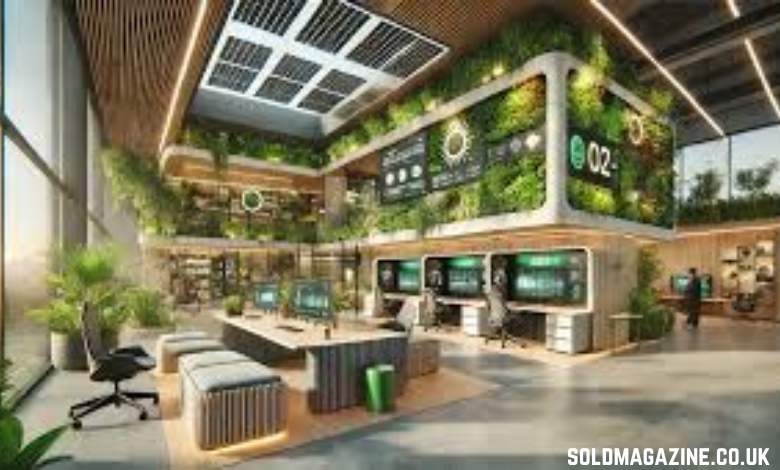In today’s corporate world, sustainability has evolved beyond a mere trend—it’s an essential element for success. Companies are increasingly recognizing that eco-friendly commercial spaces not only benefit the environment but also enhance employee productivity, reduce operational costs, and strengthen brand reputation. Designing an eco-smart workspace requires careful planning, innovative thinking, and a commitment to sustainability. Here’s a closer look at how businesses can create environmentally conscious commercial buildings that are both functional and stylish.
The Importance of Sustainable Commercial Spaces
Commercial buildings account for a significant portion of global energy consumption and carbon emissions. According to the U.S. Environmental Protection Agency, commercial buildings use nearly 20% of all energy consumed in the country. Reducing this footprint through sustainable design practices is essential for businesses that want to contribute to environmental preservation. Beyond environmental responsibility, sustainable buildings offer tangible benefits: lower utility bills, improved indoor air quality, and enhanced employee well-being.
More and more, employees are gravitating towards organizations that place a strong emphasis on sustainability. A workspace designed with green principles—such as natural lighting, energy-efficient systems, and indoor plants—can boost morale, increase productivity, and reduce absenteeism. For clients and visitors, eco-smart offices signal corporate responsibility, reinforcing a company’s commitment to a sustainable future.
Key Elements of Eco-Smart Workspaces
1. Energy Efficiency
A highly effective way to create an eco-friendly commercial space is by prioritizing energy efficiency. Upgrading to LED lighting, smart thermostats, and motion-sensor systems can significantly cut electricity usage, while energy-efficient appliances and HVAC systems help the building run with minimal waste. In sunny states like Utah, harnessing solar energy through rooftop panels or solar-powered systems is an excellent way to reduce reliance on non-renewable energy and lower utility costs, making your commercial space both sustainable and cost-effective.
2. Sustainable Materials
Choosing the right materials is another critical factor in eco-smart design. Recycled, reclaimed, and renewable materials reduce the demand for new resources and lower the building’s overall environmental impact. For example, bamboo flooring, recycled glass countertops, and low-VOC paints contribute to a healthier indoor environment while maintaining aesthetic appeal. Prioritizing sustainable materials during construction or renovation helps companies demonstrate environmental responsibility from the ground up.
3. Water Conservation
Water is a precious resource, and commercial buildings can consume vast amounts if left unchecked. Installing low-flow faucets, water-efficient toilets, and automated irrigation systems can significantly reduce water usage. Collecting and reusing rainwater for landscaping or other non-potable purposes adds another layer of sustainability. Water-conscious design not only conserves resources but also lowers water bills over time.
4. Indoor Environmental Quality
The health and comfort of employees should be at the center of any eco-smart workspace. Ensuring proper ventilation, controlling humidity, and using non-toxic materials help create a clean and safe environment. Natural lighting, combined with energy-efficient windows, reduces the need for artificial lighting while providing psychological benefits. Incorporating biophilic elements, such as indoor plants and green walls, further improves air quality and fosters a connection with nature.
5. Smart Building Technology
Technology plays a pivotal role in sustainable commercial spaces. Smart building systems monitor energy usage, lighting, temperature, and water consumption in real-time. These systems allow facility managers to make informed decisions, identify inefficiencies, and reduce waste. Automation and data analytics not only enhance sustainability but also improve operational efficiency and employee comfort.
The Long-Term Benefits
Investing in eco-smart workspaces yields both environmental and financial rewards. Energy-efficient designs reduce utility costs, while sustainable materials and technologies can increase property value. Moreover, businesses that demonstrate environmental responsibility often experience enhanced brand reputation, attracting both clients and top talent. In an era where corporate social responsibility is increasingly scrutinized, green commercial spaces are more than just an aesthetic choice—they’re a strategic business decision.
In Conclusion
Eco-smart workspaces represent the future of commercial building design. By focusing on energy efficiency, sustainable materials, water conservation, indoor environmental quality, and smart technologies, businesses can create spaces that are environmentally responsible, cost-effective, and inspiring for employees. The shift toward sustainable commercial spaces is not just about reducing carbon footprints; it’s about creating healthier, more productive environments that support both people and the planet.
Investing in sustainability today ensures a brighter, greener tomorrow—not just for your business, but for the world.




